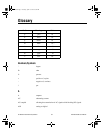
Glossary
©
National Instruments Corporation G-3 PCI-4451/4452 User Manual
B
b bit—one binary digit, either 0 or 1
B byte—eight related bits of data, an eight-bit binary number. Also used to
denote the amount of memory required to store one byte of data
bandwidth the range of frequencies present in a signal, or the range of frequencies to
which a measuring device can respond
base address a memory address that serves as the starting address for programmable
registers. All other addresses are located by adding to the base address.
binary a number system with a base of 2
bipolar a signal range that includes both positive and negative values (for example,
–5 V to +5 V)
BNC a type of coaxial signal connector
buffer temporary storage for acquired or generated data (software)
burst-mode a high-speed data transfer in which the address of the data is sent followed
by back-to-back data words while a physical signal is asserted
bus the group of conductors that interconnect individual circuitry in a computer.
Typically, a bus is the expansion vehicle to which I/O or other devices are
connected. Examples of PC buses are the ISA and PCI bus.
bus master a type of a plug-in board or controller with the ability to read and write
devices on the computer bus
C
CCelsius
CalDAC calibration DAC
channel pin or wire lead to which you apply or from which you read the analog or
digital signal. Analog signals can be single-ended or differential. For digital
signals, you group channels to form ports. Ports usually consist of either
four or eight digital channels.
circuit trigger a condition for starting or stopping clocks
User.book Page 3 Tuesday, April 14, 1998 10:20 AM


















